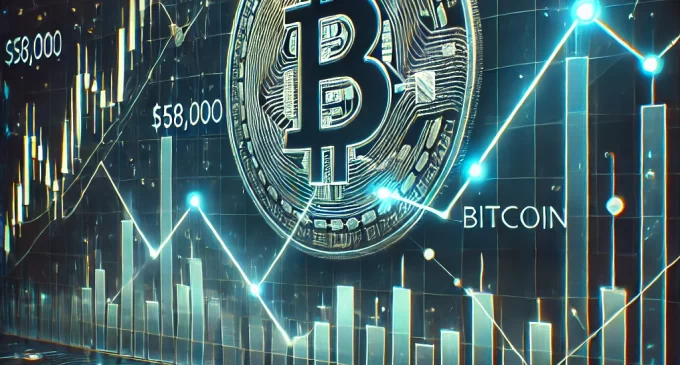
Introduction
Bitcoin, the world’s largest cryptocurrency, experienced a sharp dip to $58,000 on September 16, 2024, as market uncertainty grew over the US Federal Reserve’s upcoming decision on interest rate cuts. The move marks a temporary retreat in Bitcoin’s value from its earlier levels, as traders and investors await clarity on the Fed’s next steps.
This volatility comes amid growing concerns over the Federal Reserve’s ability to manage inflation and maintain economic stability without causing disruptions in both traditional and crypto markets. The anticipated rate cut has led to mixed reactions across various sectors, particularly within the cryptocurrency space, where Bitcoin’s price is heavily influenced by macroeconomic factors such as inflation, interest rates, and monetary policy.
In this article, we will explore the factors contributing to Bitcoin’s brief decline, the Federal Reserve’s rate cut expectations, and the broader implications for both the cryptocurrency market and traditional financial systems.
Bitcoin’s Recent Performance
Bitcoin, known for its volatile price movements, has experienced a rollercoaster ride throughout 2024. From reaching new all-time highs earlier in the year, Bitcoin has seen increased fluctuations due to various macroeconomic events, including inflation fears, regulatory changes, and rising interest rates.
In mid-September 2024, Bitcoin had been trading comfortably above the $60,000 mark, reflecting renewed optimism among investors after a period of consolidation. However, on September 16, 2024, Bitcoin suddenly dropped to $58,000, marking a significant decline in value over a short period. While the price rebounded slightly after the dip, the drop signaled market jitters over the Federal Reserve’s potential actions.
The Federal Reserve’s Rate Cut Decision
The primary driver behind Bitcoin’s recent dip lies in the broader macroeconomic environment, particularly the Federal Reserve’s upcoming interest rate decision. After months of speculation, the Fed faces mounting pressure to cut interest rates in response to rising inflation and slowing economic growth.
The debate among economists and policymakers revolves around the size of the rate cut. While some argue for a modest cut of 25 basis points (0.25%) to ease inflationary pressures, others advocate for a more aggressive cut of 50 basis points (0.50%) to spur economic activity and prevent a potential recession. The lack of consensus has caused uncertainty in both traditional financial markets and the cryptocurrency market.
Bitcoin, as a speculative asset, tends to react sharply to macroeconomic shifts, particularly changes in monetary policy. The fear of a larger-than-expected rate cut has created anxiety among investors, prompting the recent sell-off that led to the dip in Bitcoin’s price.
Why Interest Rates Matter To Bitcoin
Bitcoin’s correlation with broader economic conditions has become increasingly evident in recent years. As a decentralized digital asset, Bitcoin’s value is influenced by multiple factors, including global demand, regulatory developments, and investor sentiment. However, monetary policy decisions, particularly in the US, have played a more prominent role in shaping Bitcoin’s price trajectory.
When interest rates rise, the cost of borrowing increases, making riskier investments like Bitcoin less attractive compared to more traditional assets like bonds. Conversely, lower interest rates encourage borrowing and risk-taking, which can boost demand for cryptocurrencies.
In the case of a Federal Reserve rate cut, the reduced cost of borrowing could potentially lead to an influx of liquidity into riskier assets, including Bitcoin. However, the current market anxiety stems from fears that an aggressive rate cut could signal deeper economic problems, leading to further market instability and a potential flight to safety, away from volatile assets like cryptocurrencies.
The Impact Of Inflation On Bitcoin
One of Bitcoin’s core appeals lies in its role as a hedge against inflation. With its capped supply of 21 million coins, Bitcoin is often compared to gold as a store of value. In times of rising inflation, investors may flock to Bitcoin as a safeguard against the erosion of fiat currency value.
However, the relationship between Bitcoin and inflation is not always straightforward. In the current scenario, while inflation remains a concern, the possibility of a rate cut complicates the narrative. An aggressive rate cut may boost short-term liquidity, but it could also heighten fears of further inflationary pressures, potentially triggering more volatility in the Bitcoin market.
The Market’s Response: Short-Term Panic Or Long-Term Opportunity?
The sharp decline in Bitcoin’s price to $58,000 has sparked a range of responses from market participants. On one hand, some view the dip as a temporary reaction to uncertainty, believing that Bitcoin will bounce back once the Federal Reserve clarifies its policy direction. These investors see any dip as a buying opportunity, especially if the rate cut leads to increased liquidity and demand for riskier assets like Bitcoin.
On the other hand, more cautious investors worry that the rate cut, combined with broader economic concerns, could lead to prolonged market instability. These participants may be more inclined to reduce their exposure to volatile assets like Bitcoin until greater clarity is achieved regarding the Fed’s actions and their long-term impact on the global economy.
Regardless of which side of the debate one falls on, the current situation underscores the growing importance of macroeconomic factors in shaping Bitcoin’s price movements. As Bitcoin continues to mature as an asset class, its correlation with traditional financial markets and central bank policies is likely to strengthen.
Broader Implications For The Financial Market
Bitcoin’s recent price movement is not happening in isolation. The broader financial market, including stocks and bonds, is also closely watching the Federal Reserve’s upcoming decision. A larger-than-expected rate cut could have ripple effects across various asset classes, influencing investor behavior and capital allocation.
For traditional financial markets, a 50-basis point cut could provide temporary relief by lowering borrowing costs and encouraging investment. However, the long-term implications of such a move are less certain. Prolonged low interest rates could fuel inflationary pressures, while also contributing to asset bubbles in both traditional and crypto markets.
In the cryptocurrency market, Bitcoin’s role as both a speculative asset and a hedge against inflation means it is particularly sensitive to such developments. As the global economy navigates an increasingly complex landscape, Bitcoin’s price movements will continue to be influenced by both internal and external factors.
Conclusion
As Bitcoin briefly slipped to $58,000 on September 16, 2024, the market remains on edge, awaiting the Federal Reserve’s decision on interest rate cuts. The uncertainty surrounding the size and impact of the cut has led to short-term volatility in the cryptocurrency market, with Bitcoin investors reacting to the broader macroeconomic environment.
While the future direction of Bitcoin’s price remains uncertain, one thing is clear: as the cryptocurrency market matures, it will continue to be influenced by major economic events and policy decisions. Investors will need to remain vigilant, closely monitoring both traditional financial markets and the actions of central banks to navigate the ongoing volatility.







There are no comments at the moment, do you want to add one?
Write a comment